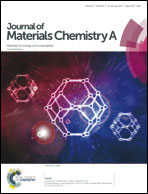Electrospun ZIF-based hierarchical carbon fiber as an efficient electrocatalyst for the oxygen reduction reaction†
Abstract
The inherently granular nature of nitrogen and metal co-doped carbons derived from metal–organic frameworks (MOFs) hinders their practical application in the oxygen reduction reaction (ORR). In this work, we have developed a novel N, Co-containing MOF-based hierarchical carbon fiber as an ORR catalyst. The products (ZCP-CFs) are synthesized by the incorporation of a Zn, Co-zeolitic imidazolate framework (Zn, Co-ZIF) with electrospun Co2+/poly(acrylonitrile) fiber, followed by carbonization and acid leaching treatment. The effects of the pyrolysis temperature and precursor on the ORR performance of the final samples were systematically studied. The results indicated that the material prepared at 900 °C (ZCP-CFs-9) was identified as the best ORR catalyst in the series of samples. Further comparison among samples obtained from different catalyst precursors also demonstrated the superior performance of ZCP-CFs-9, with its more positive half-wave potential (−0.135 V vs. Ag/AgCl), higher diffusion-limited and kinetic-limiting currents and higher selectivity (number of electrons transferred n = ∼3.97) than Zn, Co-ZIF derived carbon and Zn, Co-ZIF free carbon fiber. Notably, the ZCP-CFs-9 catalyst exhibited very close activity to a commercial Pt/C catalyst with better durability and stronger tolerance to methanol crossover. The remarkable ORR performance may be ascribed to its unique structure, such as its large surface area and hierarchical porosity, the dispersed and protected Co nanoparticles and N functionalized carbon framework, as well as the abundant graphitic carbon and its 1D fibrous structure. Considering the diversity of MOFs and electrospinnable polymer precursors, this strategy may be further extended to other MOF-based carbon fibers for energy storage and conversion.



 Please wait while we load your content...
Please wait while we load your content...